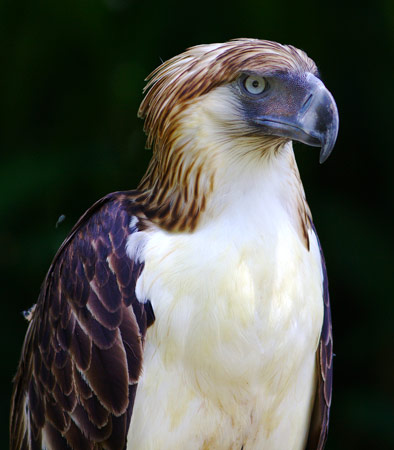National Symbols: National Bird
Philippine Eagle (common name)
Pithecophaga jefferyi (scientific name)
Designation
Official
Classification
- Kingdom: Animalia
- Phylum: Chordata
- Class: Aves
- Order: Accipitriformes
- Family: Accipitridae
- Genus: Pithecophaga
- Species: P. jefferyi
The Bird
A formidable bird of prey, the great Philippine eagle is extremely rare and one of the two largest eagle species in the world. This bird measures 86–102 centimeters (2.8–3.4 ft) in length, weighs 4.7–8 kilograms (10–18 lb), and has a wingspan of approximately 2 meters (6.5 ft). It has brown dorsal feathers and a white underbelly and underwings. Shaggy brown-and-black-striped feathers on its head resemble a crest. This bird's heavy legs, powerful claws, and high-arched bill make it an expert predator.
The great Philippine eagle feeds on small animals, including monkeys, civets, flying lemurs, reptiles, and other birds. It mates for life, and the female attains sexual maturity when she is 5 years old. Nest building signals the beginning of courtship, after which the female typically lays one egg. Both parents help in the incubation, and if the chick fails to hatch, the female lays another egg the following year. The newly hatched eaglet is fed and cared for by both parents for nearly 20 months, although it is ready to fledge after five months. Eaglets have been known to make their first kill when they are 10 months old. This bird is also known as onkey-eating eagle.
The Significance
The great Philippine eagle is endemic to the Philippines and can be found on all four of the country's major islands, with a majority of the population existing in Mindanao. Because of its small range and rapidly declining population, the bird is listed as "critically endangered" on the IUCN Red List, with a total adult population estimated at 180–500 birds. In 1915 Phillippines President Fidel V. Ramos declared the Great Philippine eagle as the country's national bird. This magnificent raptor's size and rarity strongly influenced the choice to honor the bird in an official capacity. Between 1967 and 2007, at least 12 stamps featuring the eagle have been issued in the Philippines, and there is also a coin featuring the eagle.
Locally the great Philippine eagle is known as the haribon or haring ibon (bird king). According to an old Philippine myth, not long ago the sky was so close to the sea that a person could reach up and touch it. The eagle, true to its tenacious nature, pecked off bits of the sky to use for its nest. Furious at the eagle’s audacity, the sky rained rocks and pulled back the sea. This, the story suggests, is how the Philippine Islands were created.
Article written for World Trade Press by WTP Staff.
Copyright © 1993—2025 World Trade Press. All rights reserved.

 Philippines
Philippines 